|
|

|
|
Author
|
Topic: Double Asteroid Redirection Test (DART)
|
Robert Pearlman
Editor Posts: 49230
From: Houston, TX
Registered: Nov 1999
|
 posted 04-11-2019 11:23 PM
posted 04-11-2019 11:23 PM
   
NASA release Double Asteroid Redirection Test (DART) MissionThe Double Asteroid Redirection Test (DART) mission is directed by NASA to the Johns Hopkins University Applied Physics Laboratory (JHU/APL) with support from NASA centers: the Jet Propulsion Laboratory (JPL), Goddard Space Flight Center (GSFC), and Johnson Space Center (JSC). 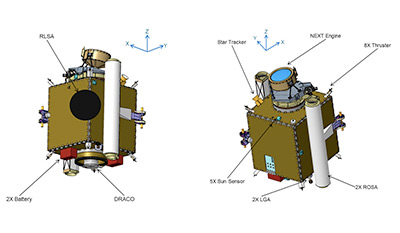 Above: Two different views of the DART spacecraft bus. The DRACO (a tortured acronym that is the Didymos Reconnaissance & Asteroid Camera for OpNav) is based on the LORRI high-resolution imaging instrument from New Horizons. The left view also shows the Radial Line Slots Array (RLSA) antenna with (solar arrays rolled up). The isometric view on the right shows a clearer view of the NEXT-C ion engine. DART will be the first demonstration of the kinetic impact technique to change the motion of an asteroid in space. The DART mission is in Phase B, led by JHU/APL and managed by the Planetary Missions Program Office at Marshall Space Flight Center for NASA's Planetary Defense Coordination Office. DART is a planetary defense-driven test of one of the technologies for preventing the Earth impact of a hazardous asteroid: the kinetic impactor. DART's primary objective is to demonstrate a kinetic impact on a small asteroid. The binary near-Earth asteroid (65803) Didymos is the target for DART. While Didymos' primary body is approximately 800 meters across, its secondary body (or "moonlet") has a 150-meter size, which is more typical of the size of asteroids that could pose a more common hazard to Earth. The DART spacecraft will achieve the kinetic impact by deliberately crashing itself into the moonlet at a speed of approximately 6 km/s, with the aid of an onboard camera and sophisticated autonomous navigation software. The collision will change the speed of the moonlet in its orbit around the main body by a fraction of one percent, enough to be measured using telescopes on Earth. 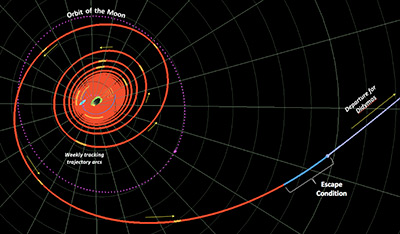 Above: DART will be co-manifested on either commercial or military launch to geosynchronous orbit between December 2020 and May 2021 and released. Using the NEXT-C ion thrust engine, DART will spiral out beyond the orbits of the geosynchronous satellites and the Moon to reach an escape point to depart the Earth-Moon system en route to Didymos. The DART spacecraft will utilize the NASA Evolutionary Xenon Thruster – Commercial (NEXT-C) solar electric propulsion system as its primary in-space propulsion system. NEXT-C is the next generation system that is based on the Dawn spacecraft propulsion system and was developed at NASA's Glenn Research Center in Cleveland, Ohio. By utilizing electric propulsion, DART is able to gain significant flexibility to the mission timeline and widen the launch window, as well as decrease the cost of the of the launch vehicle that gets the mission off Earth and into orbit. NASA's DART spacecraft's launch window range begins in late December 2020 and runs through May 2021. It will intercept Didymos' moonlet in early October 2022, when the Didymos system is within 11 million kilometers of Earth, enabling observations by ground-based telescopes and planetary radar to measure the change in momentum imparted to the moonlet. |
Robert Pearlman
Editor Posts: 49230
From: Houston, TX
Registered: Nov 1999
|
 posted 04-11-2019 11:24 PM
posted 04-11-2019 11:24 PM
   
NASA release NASA Awards Launch Services Contract for Asteroid Redirect Test MissionNASA has selected SpaceX in Hawthorne, California, to provide launch services for the agency's Double Asteroid Redirection Test (DART) mission, the first-ever mission to demonstrate the capability to deflect an asteroid by colliding a spacecraft with it at high speed – a technique known as a kinetic impactor. The total cost for NASA to launch DART is approximately $69 million, which includes the launch service and other mission related costs. The DART mission currently is targeted to launch in June 2021 on a Falcon 9 rocket from Space Launch Complex 4E at Vandenberg Air Force Base in California. By using solar electric propulsion, DART will intercept the asteroid Didymos' small moon in October 2022, when the asteroid will be within 11 million kilometers of Earth. |
Robert Pearlman
Editor Posts: 49230
From: Houston, TX
Registered: Nov 1999
|
 posted 06-23-2020 09:20 AM
posted 06-23-2020 09:20 AM
   
International Astronomical Union (IAU) release IAU Approves Name of Target of First NASA and ESA Planetary Defence MissionsThe International Astronomical Union has just approved an official name for a tiny asteroid satellite set to become the first-ever target of an asteroid deflection mission. The satellite is the smaller of two bodies in the near-Earth asteroid system Didymos, and will now be distinguished from its primary object by the name Dimorphos. In July 2021, just over a year from now, NASA will launch the Double Asteroid Redirection Test (DART) mission. This first full-scale demonstration of asteroid deflection technology will target the smaller body in the binary asteroid system known as Didymos, and will be followed in 2024 by the ESA space probe Hera. In recognition of the asteroid moon's significance in these pioneering missions, it has been given an official name: Dimorphos. Together, the DART and Hera missions, and the international research collaboration known as the Asteroid Impact and Deflection Assessment (AIDA), will demonstrate deflection technology that could be used to protect Earth from hazardous asteroids by shunting them off a collision course. Didymos does not pose a risk of striking Earth, and is the most easily reachable asteroid system of its size, with a primary body about 780 metres in diameter. The smaller body is about 160 metres in diameter — roughly the size of the Great Pyramid in Egypt. First spotted in 1996 by Joe Montani of the Spacewatch Project at the University of Arizona, the asteroid system's binary nature was not discovered until 2003, when Petr Pravec of the Ondřejov Observatory in the Czech Republic found the characteristic signs of a binary system in his observations. It was at this point that it received its official name. As the original discoverer, Montani suggested the system be named Didymos, meaning twin in Greek, to reflect its composition, a name which the IAU quickly approved. While the larger body and the system as a whole have gone by the name Didymos since then, the smaller body has been referred to by many names, including the provisional designation S/2003 (65803) 1 and the nicknames Didymos B and Didymoon, but was never given its own official name. When it was identified as an ideal target for AIDA, the DART and Hera teams decided to seek a permanent designation and an official name by which it could be distinguished from its larger companion. The body that officially approves the names of minor planets and their satellites is the IAU Working Group Small Body Nomenclature (WGSBN), under the IAU Division F Planetary Systems and Astrobiology [1]. The WGSBN received the proposal to name the satellite Dimorphos, with the following citation: "Dimorphos, Greek for 'having two forms', is the smaller member of the (65803) Didymos system. As the target of the DART and Hera space missions, it will become the first celestial body in cosmic history whose form was substantially changed as a result of human intervention (the DART impact)." The WGSBN accepted the proposal, and the object obtained its final designation as (65803) Didymos I = Dimorphos. The name of the moon was suggested by Kleomenis Tsiganis, a planetary scientist at the Aristotle University of Thessaloniki and a member of both the DART and Hera teams. He explains that the name Dimorphos "has been chosen in anticipation of its changes. It will be known to us in two very different forms, the one seen by DART before the impact, and the other seen by Hera a few years later." At present there are 546 077 numbered minor planets, of which 22 129 have official names [2]. The catalogue of minor planets and comets is maintained by the Minor Planet Center (MPC) [3], a service of the IAU. Most of the minor planets belong to the Main Asteroid Belt, in the region between the orbits of Mars and Jupiter. There are 22 735 classified as Near Earth Asteroids (NEA), many of which have orbits that approach the Earth. Didymos belongs to the NEA group. In the minor planet catalogue there are also many examples from the outer regions of the Solar System, objects known as Centaurs and Trans-Neptunian Objects (TNOs). Many minor planets have companions; 390 binaries and 15 triple systems have so far been discovered [4]. The binary comprising Didymos and Dimorphos has become the 26th system with approved names for its components. Dimorphos, with a size of 160 metres in diameter, is also one of the smallest objects to get a permanent name. After its launch next year, DART is scheduled to reach Dimorphos in 2022, deliberately colliding with it and creating a kinetic impact intended to alter the satellite's trajectory. The ESA space probe Hera will be launched two years later and is scheduled to arrive at Dimorphos in 2027, where it will perform a close-up survey to assess the effects of the DART impact on the satellite's form and orbit. The DART impact will be recorded by the LICIACube CubeSat, provided by the Italian Space Agency, which will be carried to Didymos by DART and deployed a few days before the collision. Longer-term effects will be studied by telescopes here on Earth and in space. The Hera mission will also deploy two CubeSats, including the Juventas CubeSat, which will use a low-frequency radar to scan the interior structure of Dimorphos, the first such scan to be performed by a spacecraft. The results of Hera's detailed investigation will be compared with the observations recorded by DART before the collision, providing important insights into the effects of the impact. G. Tancredi, president of IAU Div. F and external member of the DART and Hera investigation teams, remarks that: "The IAU has been closely following the development of the research on the Near-Earth Objects and their threat for life on Earth. The IAU Working Group Near Earth Objects (WGNEO) was formed in the early 1990s to coordinate the NEO studies and to provide timely advice on any objects that threaten collision with the Earth." |
Robert Pearlman
Editor Posts: 49230
From: Houston, TX
Registered: Nov 1999
|
 posted 02-17-2021 12:08 PM
posted 02-17-2021 12:08 PM
   
NASA release DART Launch Moves to Secondary WindowThe Double Asteroid Redirection Test (DART), NASA's first flight demonstration for planetary defense, seeks to test and validate a method to protect Earth in case of an asteroid impact threat. The mission aims to shift an asteroid's orbit through kinetic impact – specifically, by impacting a spacecraft into the smaller member of the binary asteroid system Didymos to change its orbital speed. At the request of Science Mission Directorate (SMD) senior leadership, a risk assessment was performed on the DART project schedule to determine the viability of the primary (July 21, 2021 to August 24, 2021) and secondary (November 24, 2021 to February 15, 2022) launch periods. Based on the results of this assessment, SMD determined the primary launch period is no longer viable and has directed the DART project pursue their secondary launch window. The DART project is currently working with SpaceX and NASA's Launch Services Program (LSP) to identify the earliest possible launch opportunity within this secondary window. This decision, in part, stems from technical challenges associated with two mission critical components: the Didymos Reconnaissance and Asteroid Camera for Optical-navigation (DRACO) imager, which needs to be reinforced to ensure it withstands the stress of launch, and the roll-out solar arrays (ROSA), which are delayed due to supply chain impacts resulting from, but not limited to, the COVID-19 pandemic. "At NASA, mission success and safety are of the utmost importance, and after a careful risk assessment, it became clear DART could not feasibly and safely launch within the primary launch window," said Thomas Zurbuchen, associate administrator for the Science Mission Directorate at NASA Headquarters in Washington. "To ensure DART is poised for mission success, NASA directed the team pursue the earliest possible launch opportunity during the secondary launch window to allow more time for DRACO testing and delivery of ROSA, and provide a safe working environment through the COVID-19 pandemic." This change reflects NASA's priority for both mission success and personnel health and safety, which are paramount for all NASA missions. While COVID-19 was not the sole factor for this delay, it has been a significant and critically contributing factor for multiple issues. Testing equipment before launch is a crucial step in all missions to ensure mission success, and project teams build time into processing schedules to accommodate for potential delays. DART will still arrive at the Didymos binary asteroid system within a few days of the originally scheduled impact date of September 30, 2022 and will carry out its kinetic impact test on the moonlet Dimorphos as planned. |
Robert Pearlman
Editor Posts: 49230
From: Houston, TX
Registered: Nov 1999
|
 posted 10-20-2021 04:15 PM
posted 10-20-2021 04:15 PM
   
NASA release DART Arrives at Vandenberg Space Force Base, Its Final Stop Before LaunchJust two days after leaving the Johns Hopkins Applied Physics Laboratory (APL) in Laurel, Maryland, in a specialized container carefully strapped to the deck of a semi-trailer truck, NASA's Double Asteroid Redirection Test (DART) spacecraft arrived in California — its final stop here on Earth. 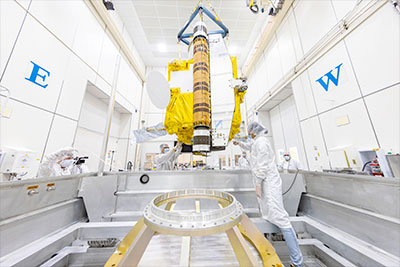 Above: Inside a cleanroom at Johns Hopkins APL, the DART spacecraft being moved into a specialized shipping container that headed across the country to Vandenberg Space Force Base near Lompoc, California, where DART is scheduled to launch from late next month. (NASA/Johns Hopkins APL/Ed Whitman) The truck, spacecraft and a small motorcade of APL engineers and technicians pulled into Vandenberg Space Force Base near Lompoc, California, on Saturday, Oct. 2, in the early afternoon local time. "Although it was just a few days of travel, this has been a journey long coming," said Elena Adams, DART mission systems engineer from APL. "We are all excited and relieved to see the truck arrive safely at Vandenberg and for DART to begin its final preparations for launch."  Above: Placed in specialized container that was carefully strapped to the deck of a semi-trailer truck, DART, followed by a small group of team members from the Johns Hopkins Applied Physics Laboratory, crossed the country from Maryland to Vandenberg Space Force Base in California. They arrived earlier this month. (NASA/Johns Hopkins APL/Ed Whitman) The spacecraft will go through a series of final tests and checks, as well as fueling, in the next few weeks as the team prepares for DART's scheduled launch aboard a SpaceX Falcon 9 rocket in late November. In mid-September, the spacecraft successfully went through a pre-shipment review to ensure each part was complete and ready for shipment. The DART team also successfully went through a flight operational readiness review to assess its readiness to start spacecraft operations once DART enters space. "We spent the last one and a half years testing DART on the ground, practicing for what's the most highly anticipated part yet: its flight to Dimorphos," Adams said. "We have a few more mission rehearsals to do, with the team practicing spacecraft launch operations from Vandenberg in California and the APL Mission Operations Center in Maryland. Once completed, we will be ready for launch and operations." DART will be the world's first mission to test planetary defense techniques, demonstrating one mitigation method of asteroid deflection, called kinetic impact. DART will impact the small asteroid moonlet Dimorphos, which orbits a larger companion, Didymos, in a binary asteroid system to change its orbital period. Although neither asteroid poses a threat to Earth, the collision with Dimorphos enables researchers to demonstrate the deflection technique along with several new technologies, and collect important data to enhance our modeling and predictive capabilities for asteroid deflection. Those enhancements will help us better prepare should an asteroid ever be discovered as a threat to Earth. |
Robert Pearlman
Editor Posts: 49230
From: Houston, TX
Registered: Nov 1999
|
 posted 11-24-2021 01:22 AM
posted 11-24-2021 01:22 AM
   
collectSPACE NASA DART launches on collision course to redirect an asteroidAfter billions of years of asteroids impacting Earth, NASA has taken its first step to strike back. The Double Asteroid Redirection Test (DART) launched on Wednesday (Nov. 24) will slam into a small space rock — the "moonlet" of a larger asteroid — to slightly knock it off course. The target, Dimorphos, poses no risk to Earth, but changing its orbit will test technologies and generate data to improve our capabilities when the next asteroid is discovered heading toward us. 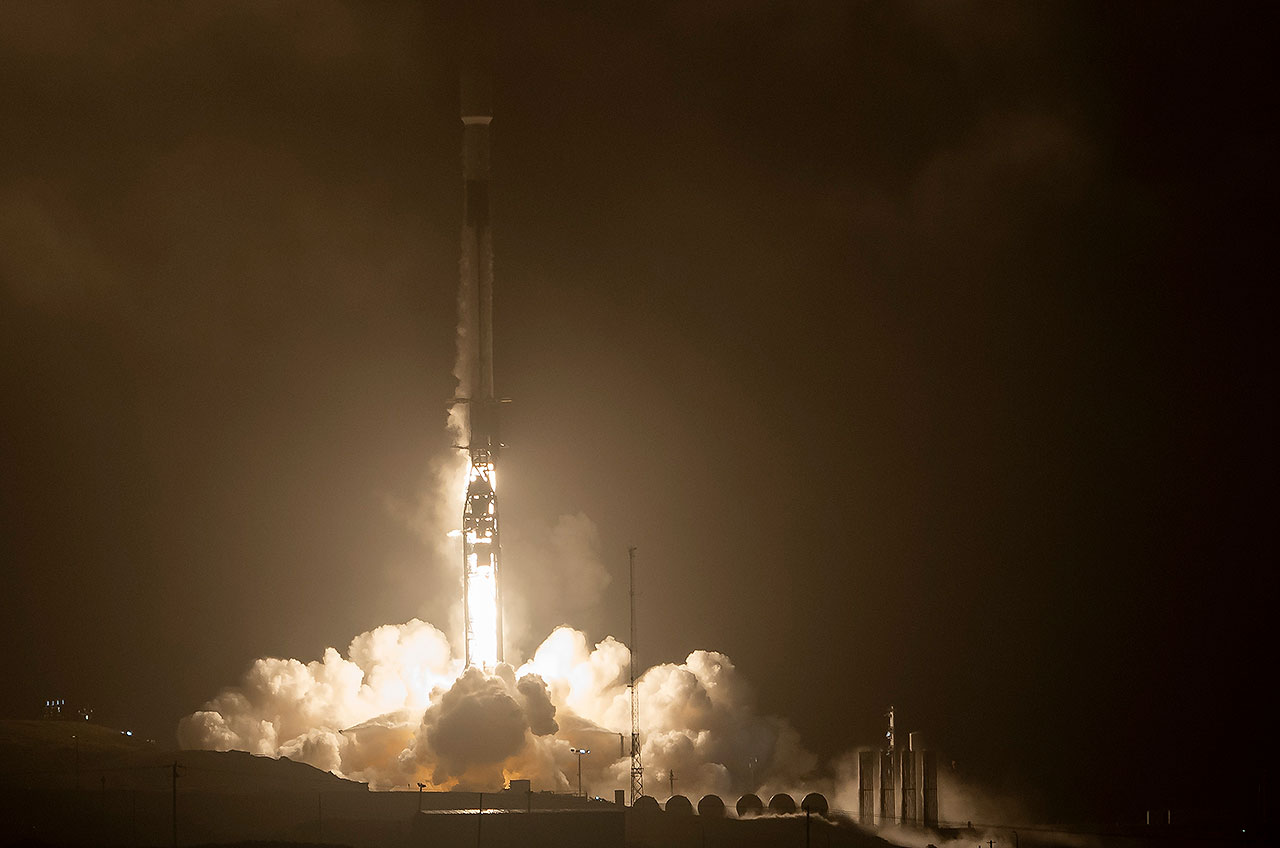 |
Robert Pearlman
Editor Posts: 49230
From: Houston, TX
Registered: Nov 1999
|
 posted 09-09-2022 01:11 PM
posted 09-09-2022 01:11 PM
   
NASA release DART Sets Sights on Asteroid TargetNASA's Double Asteroid Redirection Test (DART) spacecraft recently got its first look at Didymos, the double-asteroid system that includes its target, Dimorphos. On Sept. 26, DART will intentionally crash into Dimorphos, the asteroid moonlet of Didymos. While the asteroid poses no threat to Earth, this is the world's first test of the kinetic impact technique, using a spacecraft to deflect an asteroid for planetary defense. 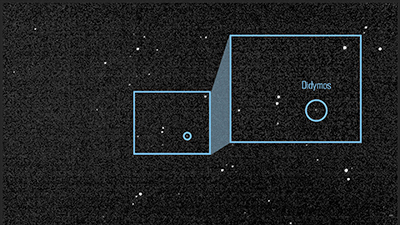 Above: This image of the light from asteroid Didymos and its orbiting moonlet Dimorphos is a composite of 243 images taken by the Didymos Reconnaissance and Asteroid Camera for Optical navigation (DRACO) on July 27, 2022. (NASA JPL DART Navigation Team) This image of the light from asteroid Didymos and its orbiting moonlet Dimorphos is a composite of 243 images taken by the Didymos Reconnaissance and Asteroid Camera for Optical navigation (DRACO) on July 27, 2022. From this distance—about 20 million miles away from DART—the Didymos system is still very faint, and navigation camera experts were uncertain whether DRACO would be able to spot the asteroid yet. But once the 243 images DRACO took during this observation sequence were combined, the team was able to enhance it to reveal Didymos and pinpoint its location. "This first set of images is being used as a test to prove our imaging techniques," said Elena Adams, the DART mission systems engineer at the Johns Hopkins Applied Physics Laboratory (APL) in Laurel, Maryland. "The quality of the image is similar to what we could obtain from ground-based telescopes, but it is important to show that DRACO is working properly and can see its target to make any adjustments needed before we begin using the images to guide the spacecraft into the asteroid autonomously." Although the team has already conducted a number of navigation simulations using non-DRACO images of Didymos, DART will ultimately depend on its ability to see and process images of Didymos and Dimorphos, once it too can be seen, to guide the spacecraft toward the asteroid, especially in the final four hours before impact. At that point, DART will need to self-navigate to impact successfully with Dimorphos without any human intervention. "Seeing the DRACO images of Didymos for the first time, we can iron out the best settings for DRACO and fine-tune the software," said Julie Bellerose, the DART navigation lead at NASA's Jet Propulsion Laboratory in Pasadena, California. "In September, we'll refine where DART is aiming by getting a more precise determination of Didymos' location." Using observations taken every five hours, the DART team will execute three trajectory correction maneuvers over the next three weeks, each of which will further reduce the margin of error for the spacecraft's required trajectory to impact. After the final maneuver on Sept. 25, approximately 24 hours before impact, the navigation team will know the position of the target Dimorphos within 2 kilometers. From there, DART will be on its own to autonomously guide itself to its collision with the asteroid moonlet. DRACO has subsequently observed Didymos during planned observations on Aug. 12, Aug. 13 and Aug. 22. |
Robert Pearlman
Editor Posts: 49230
From: Houston, TX
Registered: Nov 1999
|
 posted 09-20-2022 02:15 PM
posted 09-20-2022 02:15 PM
   
NASA release DART Tests Autonomous Navigation System Using Jupiter and EuropaAfter capturing images of one of the brightest stars in Earth's night sky, the Double Asteroid Redirection Test's (DART) camera recently set its sights on another eye-catching spectacle: Jupiter and its four largest moons. 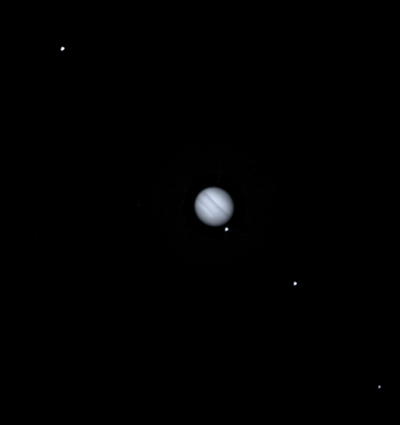 Above: A cropped composite of a DRACO image centered on Jupiter taken during one of SMART Nav's tests. DART was approximately 16 million miles (26 million km) from Earth when the image was taken, with Jupiter approximately 435 million miles (700 million km) away from the spacecraft. (NASA/Johns Hopkins APL) As NASA's DART spacecraft cruises toward its highly-anticipated Sept. 26 encounter with the binary asteroid Didymos, the spacecraft's imager — the Didymos Reconnaissance and Asteroid Camera for Optical navigation, or DRACO — has snapped thousands of pictures of stars. The pictures give the Johns Hopkins Applied Physics Laboratory (APL) team leading the mission for NASA the data necessary to support ongoing spacecraft testing and rehearsals in preparation for the spacecraft's kinetic impact into Dimorphos, the moon of Didymos. As the only instrument on DART, DRACO will capture images of Didymos and Dimorphos; it will also support the spacecraft's autonomous guidance system — the Small-body Maneuvering Autonomous Real Time Navigation (SMART Nav) — to guide DART to impact. On July 1 and August 2 the mission operations team pointed the DRACO imager to Jupiter to test the SMART Nav system. The team used it to detect and target Jupiter's moon Europa as it emerged from behind Jupiter, similar to how Dimorphos will visually separate from the larger asteroid Didymos in the hours leading up to impact. While the test obviously didn't involve DART colliding with Jupiter or its moons, it did give the APL-led SMART Nav team the chance to assess how well the SMART Nav system performs in flight. Before this Jupiter test, SMART Nav testing was done via simulations on the ground. The SMART Nav team gained valuable experience from the test, including for how the SMART Nav team views data from the spacecraft. "Every time we do one of these tests, we tweak the displays, make them a little bit better and a little bit more responsive to what we will actually be looking for during the real terminal event," said Peter Ericksen SMART Nav software engineer at APL. The DART spacecraft is designed to operate fully autonomously during the terminal approach, but the SMART Nav team will be monitoring how objects are tracked in the scene, including their intensities, number of pixels, and how consistently they're being identified. Corrective action using preplanned contingencies will only be taken if there are significant and mission-threatening deviations from expectations. With Jupiter and its moons, the team had a chance to better understand how the intensities and number of pixels of objects might vary as the targets move across the detector. The image above — taken when DART was approximately 16 million miles (26 million km) from Earth with Jupiter approximately 435 million miles (700 million km) away from the spacecraft — is a cropped composite of a DRACO image centered on Jupiter taken during one of these SMART Nav tests. Two brightness and contrast stretches, made to optimize Jupiter and its moons, respectively, were combined to form this view. From left to right are Ganymede, Jupiter, Europa, Io, and Callisto. "The Jupiter tests gave us the opportunity for DRACO to image something in our own solar system," said Carolyn Ernst, DRACO instrument scientist at APL. "The images look fantastic, and we are excited for what DRACO will reveal about Didymos and Dimorphos in the hours and minutes leading up to impact!" DRACO is a high-resolution camera inspired by the imager on NASA's New Horizons spacecraft that returned the first close-up images of the Pluto system and of the Kuiper Belt object Arrokoth. |
Robert Pearlman
Editor Posts: 49230
From: Houston, TX
Registered: Nov 1999
|
 posted 09-26-2022 06:53 PM
posted 09-26-2022 06:53 PM
   
collectSPACE NASA's DART spacecraft impacts asteroid in planetary defense demoA NASA robotic probe has slammed into an asteroid and been destroyed. The spacecraft's sacrifice was in not vain, though — its loss may someday help save life on Earth. The Double Asteroid Redirection Test (DART) completed its mission on Monday (Sept. 26), ending its 10-month journey by crashing into Dimorphos, a "moonlet" of the asteroid Didymos. Its impact marked the the first time that a spacecraft autonomously navigated to a target asteroid and intentionally collided with it in a try at changing the rock's motion in a way that could be measured by telescopes back on Earth. 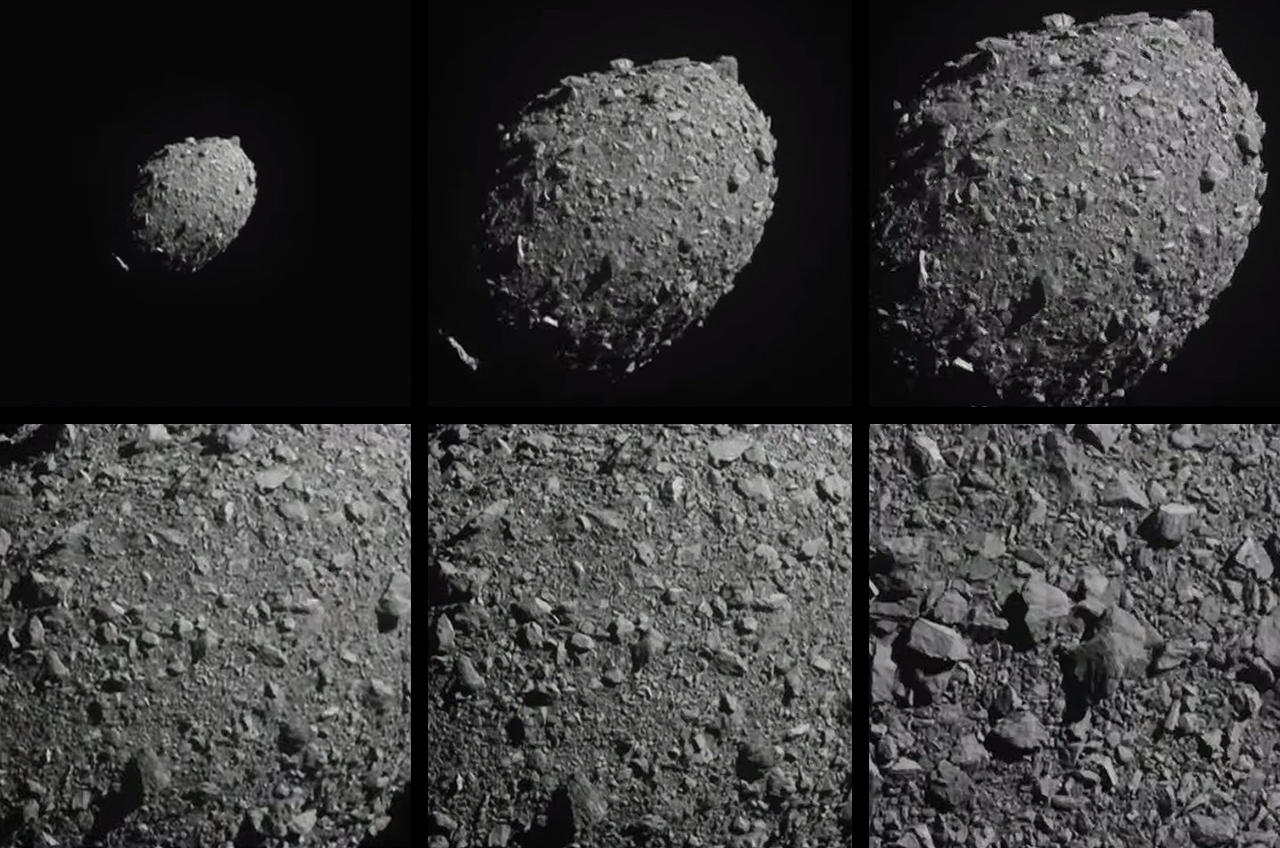 |
Robert Pearlman
Editor Posts: 49230
From: Houston, TX
Registered: Nov 1999
|
 posted 09-29-2022 03:14 PM
posted 09-29-2022 03:14 PM
   
NASA release Webb, Hubble Capture Detailed Views of DART ImpactTwo of NASA's Great Observatories, the James Webb Space Telescope and the Hubble Space Telescope, have captured views of a unique NASA experiment designed to intentionally smash a spacecraft into a small asteroid in the world's first-ever in-space test for planetary defense. These observations of NASA's Double Asteroid Redirection Test (DART) impact mark the first time that Webb and Hubble simultaneously observed the same celestial target. 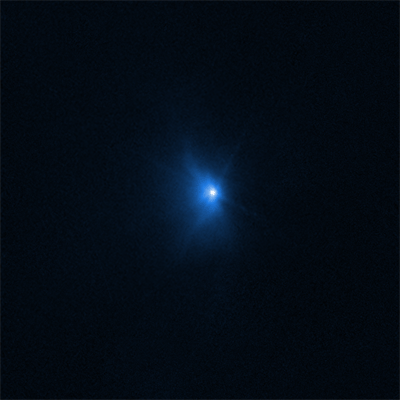 Above: This animated GIF combines three of the images NASA's Hubble Space Telescope captured after NASA's Double Asteroid Redirection Test (DART) intentionally impacted Dimorphos, a moonlet asteroid in the double asteroid system of Didymos. The animation spans from 22 minutes after impact to 8.2 hours after the collision took place. As a result of the impact, the brightness of the Didymos-Dimorphos system increased by 3 times. The brightness also appears to hold fairly steady, even eight hours after impact. (Science: NASA, ESA, Jian-Yang Li [PSI]; animation: Alyssa Pagan [STScI]) On Sept. 26, 2022, at 7:14 pm EDT, DART intentionally crashed into Dimorphos, the asteroid moonlet in the double-asteroid system of Didymos. It was the world's first test of the kinetic impact mitigation technique, using a spacecraft to deflect an asteroid that poses no threat to Earth, and modifying the object's orbit. DART is a test for defending Earth against potential asteroid or comet hazards. The coordinated Hubble and Webb observations are more than just an operational milestone for each telescope – there are also key science questions relating to the makeup and history of our solar system that researchers can explore when combining the capabilities of these observatories. "Webb and Hubble show what we've always known to be true at NASA: We learn more when we work together," said NASA Administrator Bill Nelson. "For the first time, Webb and Hubble have simultaneously captured imagery from the same target in the cosmos: an asteroid that was impacted by a spacecraft after a seven-million-mile journey. All of humanity eagerly awaits the discoveries to come from Webb, Hubble, and our ground-based telescopes – about the DART mission and beyond." 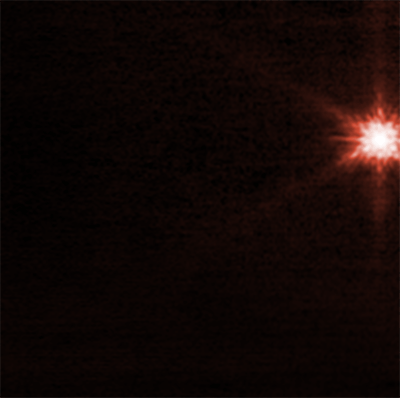 Above: This animation, a timelapse of images from NASA's James Webb Space Telescope, covers the time spanning just before impact at 7:14 p.m. EDT, Sept. 26, through 5 hours post-impact. Plumes of material from a compact core appear as wisps streaming away from where the impact took place. An area of rapid, extreme brightening is also visible in the animation. (Science: NASA, ESA, CSA, Cristina Thomas [Northern Arizona University], Ian Wong [NASA-GSFC]; Joseph DePasquale [STScI]) Observations from Webb and Hubble together will allow scientists to gain knowledge about the nature of the surface of Dimorphos, how much material was ejected by the collision, and how fast it was ejected. Additionally, Webb and Hubble captured the impact in different wavelengths of light – Webb in infrared and Hubble in visible. Observing the impact across a wide array of wavelengths will reveal the distribution of particle sizes in the expanding dust cloud, helping to determine whether it threw off lots of big chunks or mostly fine dust. Combining this information, along with ground-based telescope observations, will help scientists to understand how effectively a kinetic impact can modify an asteroid's orbit. Webb Captures Impact Site Before and After Collision Webb took one observation of the impact location before the collision took place, then several observations over the next few hours. Images from Webb's Near-Infrared Camera (NIRCam) show a tight, compact core, with plumes of material appearing as wisps streaming away from the center of where the impact took place. Observing the impact with Webb presented the flight operations, planning, and science teams with unique challenges, because of the asteroid's speed of travel across the sky. As DART approached its target, the teams performed additional work in the weeks leading up to the impact to enable and test a method of tracking asteroids moving over three times faster than the original speed limit set for Webb. "I have nothing but tremendous admiration for the Webb Mission Operations folks that made this a reality," said principal investigator Cristina Thomas of Northern Arizona University in Flagstaff, Arizona. "We have been planning these observations for years, then in detail for weeks, and I'm tremendously happy this has come to fruition." Scientists also plan to observe the asteroid system in the coming months using Webb's Mid-Infrared Instrument (MIRI) and Webb's Near-Infrared Spectrograph (NIRSpec). Spectroscopic data will provide researchers with insight into the asteroid's chemical composition. Webb observed the impact over five hours total and captured 10 images. The data was collected as part of Webb's Cycle 1 Guaranteed Time Observation Program 1245 led by Heidi Hammel of the Association of Universities for Research in Astronomy (AURA). Hubble Images Show Movement of Ejecta After Impact Hubble also captured observations of the binary system ahead of the impact, then again 15 minutes after DART hit the surface of Dimorphos. Images from Hubble's Wide Field Camera 3 show the impact in visible light. Ejecta from the impact appear as rays stretching out from the body of the asteroid. The bolder, fanned-out spike of ejecta to the left of the asteroid is in the general direction from which DART approached.  Above: These images from NASA's Hubble Space Telescope, taken (left to right) 22 minutes, 5 hours, and 8.2 hours after NASA's Double Asteroid Redirection Test (DART) intentionally impacted Dimorphos, show expanding plumes of ejecta from the asteroid's body. The Hubble images show ejecta from the impact that appear as rays stretching out from the body of the asteroid. The bolder, fanned-out spike of ejecta to the left of the asteroid is in the general direction from which DART approached. These observations, when combined with data from NASA's James Webb Space Telescope, will allow scientists to gain knowledge about the nature of the surface of Dimorphos, how much material was ejected by the collision, how fast it was ejected, and the distribution of particle sizes in the expanding dust cloud. (Science: NASA, ESA, Jian-Yang Li [PSI]; image processing: Alyssa Pagan [STScI]) Some of the rays appear to be curved slightly, but astronomers need to take a closer look to determine what this could mean. In the Hubble images, astronomers estimate that the brightness of the system increased by three times after impact, and saw that brightness hold steady, even eight hours after impact. Hubble plans to monitor the Didymos-Dimorphos system 10 more times over the next three weeks. These regular, relatively long-term observations as the ejecta cloud expands and fades over time will paint a more complete picture of the cloud's expansion from the ejection to its disappearance. "When I saw the data, I was literally speechless, stunned by the amazing detail of the ejecta that Hubble captured," said Jian-Yang Li of the Planetary Science Institute in Tucson, Arizona, who led the Hubble observations. "I feel lucky to witness this moment and be part of the team that made this happen." Hubble captured 45 images in the time immediately before and following DART's impact with Dimorphos. The Hubble data was collected as part of Cycle 29 General Observers Program 16674. "This is an unprecedented view of an unprecedented event," summarized Andy Rivkin, DART investigation team lead of the Johns Hopkins University Applied Physics Laboratory in Laurel, Maryland. |
Robert Pearlman
Editor Posts: 49230
From: Houston, TX
Registered: Nov 1999
|
 posted 10-11-2022 01:44 PM
posted 10-11-2022 01:44 PM
   
NASA release NASA Confirms DART Mission Impact Changed Asteroid's Motion in SpaceAnalysis of data obtained over the past two weeks by NASA's Double Asteroid Redirection Test (DART) investigation team shows the spacecraft's kinetic impact with its target asteroid, Dimorphos, successfully altered the asteroid's orbit. This marks humanity's first time purposely changing the motion of a celestial object and the first full-scale demonstration of asteroid deflection technology. 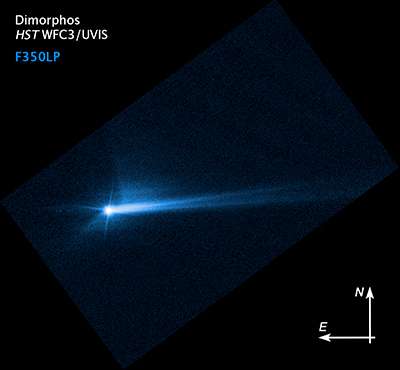 Above: This imagery from NASA's Hubble Space Telescope from Oct. 8, 2022, shows the debris blasted from the surface of Dimorphos 285 hours after the asteroid was intentionally impacted by NASA's DART spacecraft on Sept. 26. The shape of that tail has changed over time. Scientists are continuing to study this material and how it moves in space, in order to better understand the asteroid. (NASA/ESA/STScI/Hubble) "All of us have a responsibility to protect our home planet. After all, it's the only one we have," said NASA Administrator Bill Nelson. "This mission shows that NASA is trying to be ready for whatever the universe throws at us. NASA has proven we are serious as a defender of the planet. This is a watershed moment for planetary defense and all of humanity, demonstrating commitment from NASA's exceptional team and partners from around the world." Prior to DART's impact, it took Dimorphos 11 hours and 55 minutes to orbit its larger parent asteroid, Didymos. Since DART's intentional collision with Dimorphos on Sept. 26, astronomers have been using telescopes on Earth to measure how much that time has changed. Now, the investigation team has confirmed the spacecraft's impact altered Dimorphos' orbit around Didymos by 32 minutes, shortening the 11 hour and 55-minute orbit to 11 hours and 23 minutes. This measurement has a margin of uncertainty of approximately plus or minus 2 minutes. Before its encounter, NASA had defined a minimum successful orbit period change of Dimorphos as change of 73 seconds or more. This early data show DART surpassed this minimum benchmark by more than 25 times. "This result is one important step toward understanding the full effect of DART's impact with its target asteroid" said Lori Glaze, director of NASA's Planetary Science Division at NASA Headquarters in Washington. "As new data come in each day, astronomers will be able to better assess whether, and how, a mission like DART could be used in the future to help protect Earth from a collision with an asteroid if we ever discover one headed our way." The investigation team is still acquiring data with ground-based observatories around the world – as well as with radar facilities at NASA Jet Propulsion Laboratory's Goldstone planetary radar in California and the National Science Foundation's Green Bank Observatory in West Virginia. They are updating the period measurement with frequent observations to improve its precision. Focus now is shifting toward measuring the efficiency of momentum transfer from DART's roughly 14,000-mile (22,530-kilometer) per hour collision with its target. This includes further analysis of the "ejecta" – the many tons of asteroidal rock displaced and launched into space by the impact. The recoil from this blast of debris substantially enhanced DART's push against Dimorphos – a little like a jet of air streaming out of a balloon sends the balloon in the opposite direction. To successfully understand the effect of the recoil from the ejecta, more information on of the asteroid's physical properties, such as the characteristics of its surface, and how strong or weak it is, is needed. These issues are still being investigated. "DART has given us some fascinating data about both asteroid properties and the effectiveness of a kinetic impactor as a planetary defense technology," said Nancy Chabot, the DART coordination lead from the Johns Hopkins Applied Physics Laboratory (APL) in Laurel, Maryland. "The DART team is continuing to work on this rich dataset to fully understand this first planetary defense test of asteroid deflection." For this analysis, astronomers will continue to study imagery of Dimorphos from DART's terminal approach and from the Light Italian CubeSat for Imaging of Asteroids (LICIACube), provided by the Italian Space Agency, to approximate the asteroid's mass and shape. Roughly four years from now, the European Space Agency's Hera project is also planned to conduct detailed surveys of both Dimorphos and Didymos, with a particular focus on the crater left by DART's collision and a precise measurement of Dimorphos' mass. Johns Hopkins APL built and operated the DART spacecraft and manages the DART mission for NASA's Planetary Defense Coordination Office as a project of the agency's Planetary Missions Program Office. Telescopic facilities contributing to the observations used by the DART team to determine this result include: Goldstone, Green Bank Observatory, Swope Telescope at the Las Campanas Observatory in Chile, the Danish Telescope at the La Silla Observatory in Chile, and the Las Cumbres Observatory global telescope network facilities in Chile and in South Africa. Neither Dimorphos nor Didymos poses any hazard to Earth before or after DART's controlled collision with Dimorphos. | |
Contact Us | The Source for Space History & Artifacts
Copyright 2022 collectSPACE.com All rights reserved.

Ultimate Bulletin Board 5.47a
|
|

|
 advertisement advertisement

|























